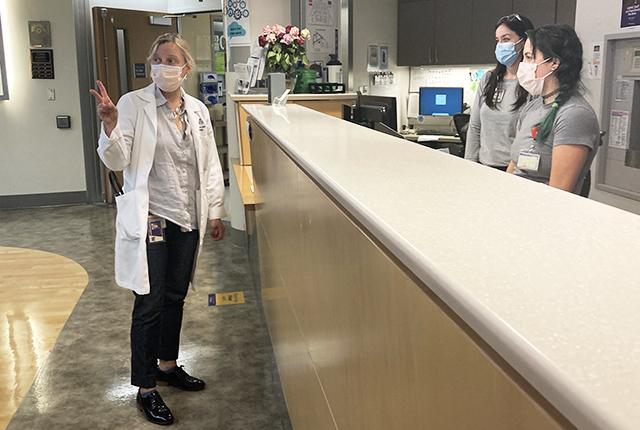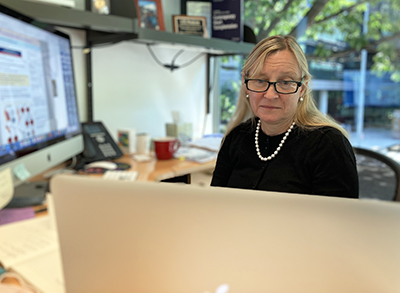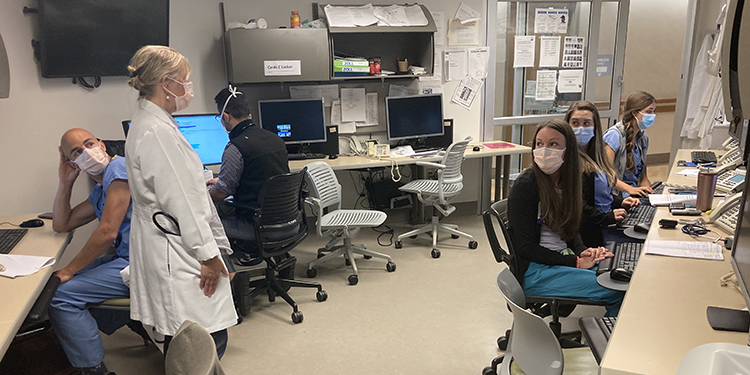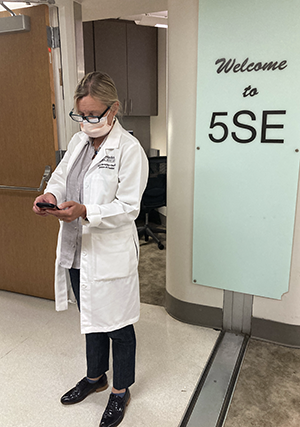
Cardiologist tells of COVID’s heart injuries, implications
Q&A: A clinician and researcher characterizes SARS-CoV-2's distinct inflammation as "an acceleration of chronic heart disease."
A year ago, evidence was emerging that SARS-CoV-2, known first for its injury to lungs, could create grave damage to the heart, as well. Dr. April Stempien-Otero, a cardiologist at UW Medicine’s Heart Institute, discusses her experience over the past 18 months as a clinician and researcher of patient cases. She offers insights about what cardiologists have learned about the virus. This conversation occurred Aug. 11, has been edited for length and clarity.
Q. You’ve historically split time between clinical and research. Are you at the hospital more these days?
A. Yes, because we have such high volumes of patients. Regular heart disease was a growth industry before COVID came along. Then you have the patients who put off care of their chronic heart condition, who are sicker. And then you have COVID patients. It’s increased our volume such that, for people with clinical expertise, it’s all hands on deck.

Q. How has it been as a care provider?
A. The hardest part was when we didn’t allow family members in the hospital. It was really difficult having to communicate with family when patients couldn’t because they were too sick or on a ventilator. I found those times to be the most emotionally exhausting.
I’ve also had so much trouble convincing some patients to get vaccinated. I think a lot of it has to do with humans’ inability to understand risk unless it’s laid out to them very clearly. Even so, I have never been so doubted as a physician. I feel like patients have put their lives in my hands for years, and now they are questioning my recommendations. That’s very humbling.
Q. How and when did you first learn that COVID-19 had implications for the heart?
A. In March 2020 I took care of my first patient with COVID, who already had been suffering with heart disease. He ended up dying acutely in the hospital. We had detailed data of his blood pressures and hemodynamics and responses to medication during hospitalization, and then his family gave us permission to do an autopsy.
That helped us see that this was patient did not die of respiratory issues caused by SARS-CoV-2 – that had been our big fear – but because he had cardiovascular collapse and his heart was unable to pump blood to his body. His heart had pre-existing inflammatory cells that we see with chronic heart conditions, but no sign of acute inflammation that we would have expected from a viral infection that caused cardiovascular collapse.
This was something entirely new. His heart condition alone could not have caused the cardiovascular collapse. It was COVID on top of the heart condition.
Q. Were you immediately afraid for your heart patients – that they’d be disproportionately affected by COVID-19?
A. Yes, I was very afraid that if they got this virus with their pre-existing heart disease, they would die. Luckily here in Seattle, the word went out and people with heart conditions were very careful early on.
That was the first wave. Then came a second wave of heart patients last summer and fall who had been staying clear of everyone, including their cardiologists. As a group, their heart conditions had gotten worse because they’d put off getting routine care. At this point, hospitals were clamoring for these patients to come back, that it was safe, and a lot of them did. We were filled to the gills all fall.
And then COVID patients increased again. This past winter, we started seeing what I think of as our third wave experience with this: patients who were younger and had pre-existing conditions, some unknown, and had mild cases of COVID at home. They were coming into the hospital three or four weeks later with significant heart damage.

Q. Could you have anticipated that?
A. It was a big surprise to all of us. It wasn’t our high-risk cardiac population, but in retrospect, I think it was a matter of time before we saw the effects of COVID on people with what we call subclinical cardiac disease. If you look at the waves of which populations got COVID over time, there was a big spike in the general population in the fall, which I think gave rise to this smaller group of young people – say, 25 to 40 – who developed heart complications.
Q. What were the conditions that increased this population’s risk for COVID?
A. Prediabetes, high blood pressure, mild cardiomyopathy or genetic issues that had not been causing problems. These people are not usually in harm’s way because medicine manages their conditions very well.
Q. What have you learned about heart inflammation in the past 18 months?
A. We used to just think that the inflammatory cells that came with conditions like high blood pressure and heart failure were kind of bystanders and a result of damage that had already happened – as opposed to actively promoting disease. COVID has made it clear that those inflammatory cells can be very powerful actors in making heart disease worse.
Before COVID, the inflammatory condition we saw most often was lymphocytic myocarditis, where the presence of a virus like influenza calls lymphocytes (inflammatory cells) to the heart muscle’s cells. It’s an immune response that temporarily destroys heart cells, but you give patients immunosuppression to resolve it or the virus would go away on its own in a week or two. There’s also allergic myocarditis, in which eosinophils invade the heart, but that’s rarer.
By contrast, with SARS-CoV-2, heart inflammation almost never involves lymphocytes or eosinophils. Instead, we see increases in monocyte/macrophages, a different type of inflammatory cells that circulate. They don’t infiltrate densely, but they’re increased enough to cause problems.
We hypothesize that people with pre-existing heart conditions probably have some of these macrophages present in their hearts, which become activated with SARS-CoV-2 and cause heart muscle damage.

So one could think of SARS-CoV-2 as an acceleration of chronic heart disease: SARS-CoV-2 causes a different kind of inflammation that, from our experience, is more persistent.
Q. If you suspect a certain type of inflammation, does that direct your treatment?
We don’t have drugs specific for different inflammation in the heart. We use high-dose steroids for both lymphocytic myocarditis and allergic myocarditis. With SARS-CoV-2, patients often are already getting treated with steroids for the lung issues. But studies have shown that even with treatment, about half of patients hospitalized with COVID have leakage of heart proteins into their blood, indicating direct damage to the heart.
The question is what will happen afterward the SARS-CoV-2 runs its course. How much heart muscle will a patient lose due to these inflammatory responses? We don’t make many new heart muscle cells as we age. And we know that, as with other toxins that kill heart muscle cells, for example, chemotherapy, if you lose enough of these cells, those tissue areas are replaced with scar tissue, the heart has to work harder, and you gradually develop heart failure.
Our whole field has been pushing toward identifying people whose risk for heart failure is greater and getting them on medications to prevent it. Is COVID creating a new group of patients that we need to track? Even if their heart function is ostensibly normal, if patients have had documented cardiac involvement with SARS-CoV-2, do we put them on medications to prevent heart failure that we would with patients who’ve had chemotherapy or lost a small area of heart due to a heart attack?
Over 2.5 million Americans have been hospitalized with COVID; studies estimate that at least one quarter of them have measurable changes in heart function. That is three times the number of patients diagnosed with lung cancer every year.
Q. Where do you think we are on the trajectory of COVID as a public health issue?
I think we’ve all seen that we can’t predict how a new disease will evolve. And that’s why we do science: We gather data, we make our best hypotheses, and we treat people with the best therapies we have. As different populations get a disease, we learn new things about how it can progress and mutate, and we have to adjust course.
We can take our masks off one week and the next week we can realize we’re in an exponential growth phase and we have to backtrack. Physicians and researchers are not surprised by continuous ups and downs when you have an entirely new disease. I think we need to get better at setting that expectation with the public.
For details about UW Medicine, please visit https://uwmedicine.org/about.